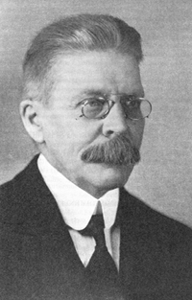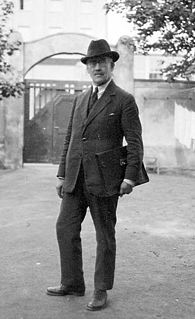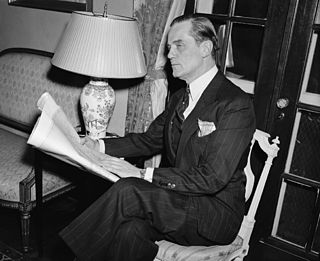 |
|---|
Aimo Cajander's second cabinet was the 10th Government of Finland. The cabinet existed from January 18, 1924 to May 31, 1924. It was a caretaker government, and its Prime Minister was Aimo Cajander. [1]
 |
|---|
Aimo Cajander's second cabinet was the 10th Government of Finland. The cabinet existed from January 18, 1924 to May 31, 1924. It was a caretaker government, and its Prime Minister was Aimo Cajander. [1]
| Portfolio | Minister | In office | Left office | Party |
|---|---|---|---|---|
| Prime Minister | Aimo Cajander | January 18, 1924 | May 31, 1924 | none |
| Minister for Foreign Affairs | Carl Enckell | January 18, 1924 | May 31, 1924 | |
| Minister of Justice | Oskar Lilius | January 18, 1924 | May 31, 1924 | |
| Minister of Defence | Viktor Henrik Schvindt | November 14, 1922 | January 18, 1924 | |
| Ivar Aminoff | March 11, 1924 | May 31, 1924 | ||
| Minister of the Interior | Yrjö Johannes Eskelä | January 18, 1924 | May 31, 1924 | |
| Minister of Finance | Hugo Relander | January 18, 1924 | May 31, 1924 | |
| Minister of Education | Yrjö Loimaranta | January 18, 1924 | May 31, 1924 | |
| Minister of Agriculture | Östen Elfving | January 18, 1924 | May 31, 1924 | |
| Minister of Transport and Public Works | Evert Skogström | January 18, 1924 | May 31, 1924 | |
| Minister of Trade and Industry | Hjalmar Procopé | January 18, 1924 | May 31, 1924 | |
| Minister of Social Affairs | Einar Böök | January 18, 1924 | May 31, 1924 |

Aimo Kaarlo Cajander was the Prime Minister of Finland up to the Winter War.

Patriotic People's Movement was a Finnish nationalist and anti-communist political party. IKL was the successor of the previously banned Lapua Movement. It existed from 1932 to 1944 and had an ideology similar to its predecessor, except that IKL participated in elections, although with limited success.

Kela, abbr. from Finnish: Kansaneläkelaitos, Swedish: Folkpensionsanstalten (Fpa), English: The Social Insurance Institution (SII), is a Finnish government agency in charge of settling benefits under national social security programs. Kela was founded in 1937 to handle retirement pay. In the 1980s and 1990s, its role was expanded to handle other fields like child benefits, unemployment benefits, sickness benefits, health insurance and student financial aid.

Kesäranta is the official residence of the Prime Minister of Finland, located in Helsinki in the neighborhood of Meilahti, overlooking Seurasaarenselkä.

Carl Johan Alexis Enckell was a Finnish politician, diplomat, officer and businessman.
Parliamentary elections were held in Finland between 1 and 3 July 1922. The Social Democratic Party remained the largest in Parliament with 53 of the 200 seats. The caretaker government of Professor Aimo Cajander (Progressive), that President Kaarlo Juho Ståhlberg had appointed in June 1922, following the resignation of Prime Minister Juho Vennola (Progressive), remained in office until Kyösti Kallio formed an Agrarian-Progressive minority government in November 1922. Voter turnout was 58.5%.
Parliamentary elections were held in Finland on 1 and 2 April 1924. Although the Social Democratic Party remained the largest in Parliament with 60 of the 200 seats, Lauri Ingman of the National Coalition Party formed a centre-right majority government in May 1924. It remained intact until the Agrarians left in November 1924. Voter turnout was 57.4%.

Kaarle Väinö Voionmaa was a Finnish professor, diplomat, member of the parliament of Finland, senator, minister and chancellor. He also was one of the most influential politicians during the early times of independent Republic of Finland. He was a Social Democrat.
Parliamentary elections were held in Finland on 1 and 2 July 1936. Following the election Prime Minister Toivo Mikael Kivimäki of the National Progressive Party was defeated in a confidence vote in September 1936 and resigned in October. Kyösti Kallio of the Agrarian League formed a centrist minority government after Pehr Evind Svinhufvud refused to allow the Social Democrats to join the government. After Svinhufvud's defeat in the February 1937 presidential election, Kallio took office as the new President in March 1937, and he allowed the Social Democrats, Agrarians and Progressives to form the first centre-left or "red soil" Finnish government. Aimo Cajander (Progressive) became Prime Minister, although the real strong men of the government were Finance Minister Väinö Tanner and Defence Minister Juho Niukkanen (Agrarian).
Parliamentary elections were held in Finland on 1 and 2 July 1939. Following the elections, the National Progressive Party-led government of Aimo Cajander continued in office. However, he was replaced by Risto Ryti's Progressive-led war government in December 1939.
Cajander is the surname of at least two Finnish families and may refer to:
Aimo Kaarlo Cajander first's cabinet was the eighth Government of Republic of Finland. Its time period was from June 2, 1922 to November 14, 1922. It was a caretaker government.
Aimo Cajander's third cabinet was the 22nd government of Republic of Finland. Cabinet's time period was from March 12, 1937 to December 1, 1939. It was Majority government.

Hjalmar Johan Fredrik Procopé was a Finnish politician and a diplomat from the Swedish People's Party. Procopé was a minister in several cabinets in the 1920s and 1930s.

The Second International Aeronautic Exhibition, (full name Second International Aeronautical Exhibition in the league Air Defence of Finland SILI) was held in Helsinki in 1938. It ran from 14 May to 22 May 1938.
Tony Aimo is a Papua New Guinean politician. He was a member of the National Parliament of Papua New Guinea from 2002 to 2012 and again from 2012 to 2013, representing the electorate of Ambunti-Drekikir Open. He was Minister for Correctional Services under Michael Somare from 2007 until 2011, although he was stood aside for three months in 2010. A long-time People's Action Party member, he was briefly reported to have joined the Papua New Guinea Party following the fall of the Somare government, only to emerge as a member of Somare's National Alliance Party.

Jaakko Kalela is a Finnish civil servant and ambassador. He worked for 33 years as Assistant to the President of the Republic and moved as Ambassador to Tallinn in 2005.
Dr. Annelis Schreiber (1927–2010) was a German botanist, lichenologist, and author who worked at the Botanische Staatssammlung München. She is noted her research on the plants of South West Africa, as well as her work with Gustav Hegi and Karl Heinz Rechinger in writing Illustrierte Flora von Mittel-Europa, a comprehensive flora of Central Europe. She described over 20 species. The standard author abbreviation A.Schreib. is used to indicate this person as the author when citing a botanical name.